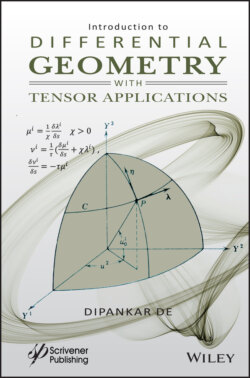Introduction to Differential Geometry with Tensor Applications

Реклама. ООО «ЛитРес», ИНН: 7719571260.
Оглавление
Группа авторов. Introduction to Differential Geometry with Tensor Applications
Table of Contents
List of Illustrations
Guide
Pages
Introduction to Differential Geometry with Tensor Applications
Preface
About the Book
Introduction
1. Preliminaries. 1.1 Introduction
1.2 Systems of Different Orders
1.3 Summation Convention Certain Index
1.3.1 Dummy Index
1.3.2 Free Index
1.4 Kronecker Symbols
1.5 Linear Equations
1.6 Results on Matrices and Determinants of Systems
1.7 Differentiation of a Determinant
1.8 Examples
1.9 Exercises
2. Tensor Algebra. 2.1 Introduction
2.2 Scope of Tensor Analysis
2.2.1 n-Dimensional Space
2.3 Transformation of Coordinates in Sn
2.3.1 Properties of Admissible Transformation of Coordinates
2.4 Transformation by Invariance
2.5 Transformation by Covariant Tensor and Contravariant Tensor
2.6 The Tensor Concept: Contravariant and Covariant Tensors. 2.6.1 Covariant Tensors
2.6.2 Contravariant Vectors
2.6.3 Tensor of Higher Order. 2.6.3.1 Contravariant Tensors of Order Two
2.6.3.2 Covariant Tensor of Order Two
2.6.3.3 Mixed Tensors of Order Two
2.7 Algebra of Tensors
2.7.1 Equality of Two Tensors of Same Type
2.8 Symmetric and Skew-Symmetric Tensors. 2.8.1 Symmetric Tensors
2.8.2 Skew-Symmetric Tensors
2.9 Outer Multiplication and Contraction. 2.9.1 Outer Multiplication
2.9.2 Contraction of a Tensor
2.9.3 Inner Product of Two Tensors
2.10 Quotient Law of Tensors
2.11 Reciprocal Tensor of a Tensor
2.12 Relative Tensor, Cartesian Tensor, Affine Tensor, and Isotropic Tensors. 2.12.1 Relative Tensors
2.12.2 Cartesian Tensors
2.12.3 Affine Tensor
2.12.4 Isotropic Tensor
2.12.5 Pseudo-Tensor
2.13 Examples
2.14 Exercises
3. Riemannian Metric. 3.1 Introduction
3.2 The Metric Tensor
3.3 Conjugate Tensor
3.4 Associated Tensors
3.5 Length of a Vector. 3.5.1 Length of Vector
3.5.2 Unit Vector
3.5.3 Null Vector
3.6 Angle Between Two Vectors
3.6.1 Orthogonality of Two Vectors
3.7 Hypersurface
3.8 Angle Between Two Coordinate Hypersurfaces
3.9 Exercises
4. Tensor Calculus. 4.1 Introduction
4.2 Christoffel Symbols
4.2.1 Properties of Christoffel Symbols
4.3 Transformation of Christoffel Symbols
4.3.1 Law of Transformation of Christoffel Symbols of 1st Kind
4.3.2 Law of Transformation of Christoffel Symbols of 2nd Kind
4.4 Covariant Differentiation of Tensor
4.4.1 Covariant Derivative of Covariant Tensor
4.4.2 Covariant Derivative of Contravariant Tensor
4.4.3 Covariant Derivative of Tensors of Type (0,2)
4.4.4 Covariant Derivative of Tensors of Type (2,0)
4.4.5 Covariant Derivative of Mixed Tensor of Type (s, r)
4.4.6 Covariant Derivatives of Fundamental Tensors and the Kronecker Delta
4.4.7 Formulas for Covariant Differentiation
4.4.8 Covariant Differentiation of Relative Tensors
4.5 Gradient, Divergence, and Curl
4.5.1 Gradient
4.5.2 Divergence
4.5.2.1 Divergence of a Mixed Tensor (1,1)
4.5.3 Laplacian of an Invariant
4.5.4 Curl of a Covariant Vector
4.6 Exercises
5. Riemannian Geometry. 5.1 Introduction
5.2 Riemannian-Christoffel Tensor
5.3 Properties of Riemann-Christoffel Tensors
5.3.1 Space of Constant Curvature
5.4 Ricci Tensor, Bianchi Identities, Einstein Tensors. 5.4.1 Ricci Tensor
5.4.2 Bianchi Identity
5.4.3 Einstein Tensor
5.5 Einstein Space
5.6 Riemannian and Euclidean Spaces. 5.6.1 Riemannian Spaces
5.6.2 Euclidean Spaces
5.7 Exercises
6. The e-Systems and the Generalized Kronecker Deltas. 6.1 Introduction
6.2 e-Systems
6.3 Generalized Kronecker Delta
6.4 Contraction of
6.5 Application of e-Systems to Determinants and Tensor Characters of Generalized Kronecker Deltas
6.5.1 Curl of Covariant Vector
6.5.2 Vector Product of Two Covariant Vectors
6.6 Exercises
7. Curvilinear Coordinates in Space. 7.1 Introduction
7.2 Length of Arc
7.3 Curvilinear Coordinates in E3
7.3.1 Coordinate Surfaces
7.3.2 Coordinate Curves
7.3.3 Line Element
7.3.4 Length of a Vector
7.3.5 Angle Between Two Vectors
7.4 Reciprocal Base Systems
7.5 Partial Derivative
7.6 Exercises
8. Curves in Space. 8.1 Introduction
8.2 Intrinsic Differentiation
8.3 Parallel Vector Fields
8.4 Geometry of Space Curves
8.4.1 Plane
8.5 Serret-Frenet Formula
8.5.1 Bertrand Curves
8.6 Equations of a Straight Line
8.7 Helix
8.7.1 Cylindrical Helix
8.7.2 Circular Helix
8.8 Exercises
9. Intrinsic Geometry of Surfaces. 9.1 Introduction
9.2 Curvilinear Coordinates on a Surface
9.3 Intrinsic Geometry: First Fundamental Quadratic Form
9.3.1 Contravariant Metric Tensor
9.4 Angle Between Two Intersecting Curves on a Surface
9.4.1 Pictorial Interpretation
9.5 Geodesic in Rn
9.6 Geodesic Coordinates
9.7 Parallel Vectors on a Surface
9.8 Isometric Surface
9.8.1 Developable
9.9 The Riemannian–Christoffel Tensor and Gaussian Curvature
9.9.1 Einstein Curvature
9.10 The Geodesic Curvature
9.11 Exercises
10. Surfaces in Space. 10.1 Introduction
10.2 The Tangent Vector
10.3 The Normal Line to the Surface
10.4 Tensor Derivatives
10.5 Second Fundamental Form of a Surface
10.5.1 Equivalence of Definition of Tensor bαβ
10.6 The Integrability Condition
10.7 Formulas of Weingarten
10.7.1 Third Fundamental Form
10.8 Equations of Gauss and Codazzi
10.9 Mean and Total Curvatures of a Surface
10.10 Exercises
11. Curves on a Surface. 11.1 Introduction
11.2 Curve on a Surface: Theorem of Meusnier
11.2.1 Theorem of Meusnier
11.3 The Principal Curvatures of a Surface
11.3.1 Umbillic Point
11.3.2 Lines of Curvature
11.3.3 Asymptotic Lines
11.4 Rodrigue’s Formula
11.5 Exercises
12. Curvature of Surface. 12.1 Introduction
12.2 Surface of Positive and Negative Curvature
12.3 Parallel Surfaces
12.3.1 Computation of and
12.4 The Gauss-Bonnet Theorem
12.5 The n-Dimensional Manifolds
12.6 Hypersurfaces
12.7 Exercises
13. Classical Mechanics. 13.1 Introduction
13.2 Newtonian Laws of Motion
13.3 Equations of Motion of Particles
13.4 Conservative Force Field
13.5 Lagrangean Equations of Motion
13.6 Applications of Lagrangean Equations
13.7 Himilton’s Principle
13.8 Principle of Least Action
13.9 Generalized Coordinates
13.10 Lagrangean Equations in Generalized Coordinates
13.11 Divergence Theorem, Green’s Theorem, Laplacian Operator, and Stoke’s Theorem in Tensor Notation
13.12 Hamilton’s Canonical Equations
13.12.1 Generalized Momenta
13.13 Exercises
14. Newtonian Law of Gravitations. 14.1 Introduction
14.2 Newtonian Laws of Gravitation
14.3 Theorem of Gauss
14.4 Poisson’s Equation
14.5 Solution of Poisson’s Equation
14.6 The Problem of Two Bodies
14.7 The Problem of Three Bodies
14.8 Exercises
Appendix A: Answers to Even-Numbered Exercises. Exercise 1.9
Exercise 3.9
Exercise 4.6
Exercise 5.7
Exercise 8.8
Exercise 9.11
Exercise 10.10
Exercise 11.5
Exercise 12.5
References
Index
Also of Interest. Check out these other titles from Scrivener Publishing
WILEY END USER LICENSE AGREEMENT
Отрывок из книги
Scrivener Publishing
.....
Solution: By expansion of determinants, we have:
Which can be written as a1jA1j = a a1jA2j = 0 and a1jA3j = 0 [we know aijAij = a].
.....